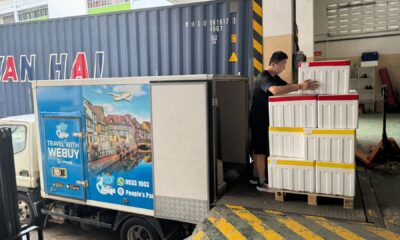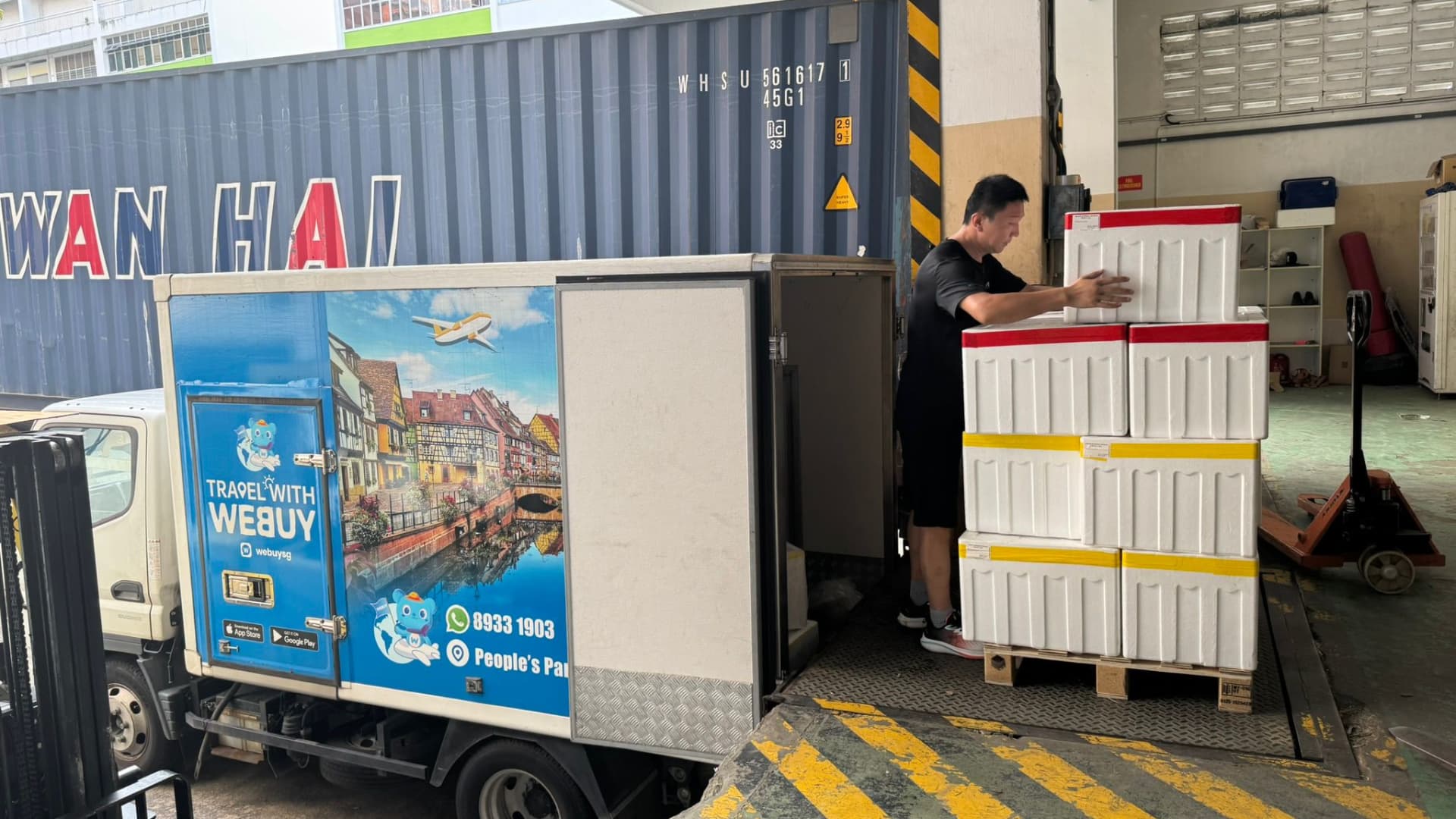Singapore-based online grocery retailer Webuy staff is offloading containers filled with goods shipped from China.
SINGAPORE — Vincent Xue runs an online grocery retail business, offering fresh produce, canned food, packaged easy-to-cook ingredients to cost-conscious local consumers in Singapore.
Xue’s Nasdaq-listed Webuy Global sources primarily from suppliers in China. Since late last year, one third of his suppliers, saddled with excess inventory in China, have offered steep discounts of up to 70%.
“Chinese domestic markets are too competitive, some larger F&B manufacturers were struggling to destock their inventories as weak consumer demand drags,” he said in Mandarin, translated by CNBC.
Xue has also gotten busier this year after sealing a partnership with Chinese e-commerce platform Pinduoduo that has been making inroads into the Southeast Asian country.
“There will be about 5-6 containers loaded with Pinduoduo’s orders coming in every week,” Xue said, and Webuy Global will support the last-mile delivery to customers.
At a time when steep tariffs are deterring Chinese exports to the U.S., while domestic consumption remains a worry, overcapacity has led Chinese producer prices to stay in deflationary territory for more than two years. Consumer inflation has remained near zero.
Still, the country is doubling down on manufacturing, and this production overdrive is rippling through global markets, stirring anxiety in Asia that a flood of cheap imports could squeeze local industries, experts said.
“Every economy around the world is concerned about being swamped by Chinese exports … many of them [have] started to put up barriers to importing from China,” said Eswar Prasad, senior professor of trade policy and economics at Cornell University.
But for inflation-worn economies, economists say the influx of low-cost Chinese goods comes with a silver-lining: lower costs for consumers. That in turn could offer central banks some relief as they juggle lowering living costs while reviving growth on the back of rising trade tensions.
For markets with limited manufacturing bases, such as Australia, cheap Chinese imports could ease the cost-of-living crisis and help bring down inflationary pressure, said Nick Marro, principal economist at Economist Intelligence Unit.
Emerging growth risks and subdued inflation may pave the way for more rate cuts across Asia, according to Nomura, which expects central banks in the region to further decouple from the Fed and deliver additional easing.
The investment bank predicts Reserve Bank of India to deliver additional rate cuts of 100 basis points during rest of the year, central banks in Philippines and Thailand to cut rates by 75 basis points each, while Australia and Indonesia could lower rates by 50 basis points, and South Korea by a quarter-percentage-point.
‘China shock’
In Singapore, the rise in costs of living was among the hot-button issues during the city-state’s election campaigning in the lead up to the polls held last month.
Core inflation in the country could surprise at the lower end of the MAS forecast range, economists at Nomura said, citing the impact of influx of cheap Chinese imports.
The city-state is not alone in witnessing the disinflationary impact as low-cost Chinese goods flood in.
“Disinflationary forces are likely to permeate across Asia,” added Nomura economists, anticipating Asian nations to feel the impact from “China shock” accelerating in the coming months.
Asian economies were already wary of China’s excess capacity, with several countries imposing anti-dumping duties to safeguard local manufacturing production, even before the roll-out of Trump’s sweeping tariffs.
In the late 1990s and early 2000s, the world economy experienced the so-called “China shock,” when a surge in cheap China-made imports helped keep inflation low while costing local manufacturing jobs.
A sequel of sorts appears to be under way as Beijing focuses on exports to offset the drag in domestic consumption.
Chinese exports to the ASEAN bloc rose 11.5% year on year in the first four months this year, as shipments to the U.S. shrank 2.5%, according to China’s official customs data. In April alone, China’s shipments to ASEAN surged 20.8%, as exports to U.S. plunged over 21% year on year.
These goods often arrive at a discount. Economists at Goldman Sachs estimate Chinese products imported by Japan in the past two years to have become about 15% cheaper compared to products from other countries.
India, Vietnam and Indonesia have imposed various protectionist measures to provide some relief for domestic producers from intense price competition, particularly in sectors facing overcapacity and cheap imports.
While for a large number of countries an influx of Chinese goods is a trade-off between lower inflation and the adverse impact on local production, countries such as Thailand could be facing a double-edged sword.
Thailand will likely be the hardest-hit by “China shock,” even sliding into a deflation this year, Nomura economists predict, while India, Indonesia and the Philippines will also see inflation falling below central banks’ targets.

 Economics1 week ago
Economics1 week ago
 Economics1 week ago
Economics1 week ago
 Blog Post6 days ago
Blog Post6 days ago
 Accounting1 week ago
Accounting1 week ago
 Personal Finance1 week ago
Personal Finance1 week ago
 Economics7 days ago
Economics7 days ago
 Personal Finance1 week ago
Personal Finance1 week ago
 Accounting1 week ago
Accounting1 week ago






















